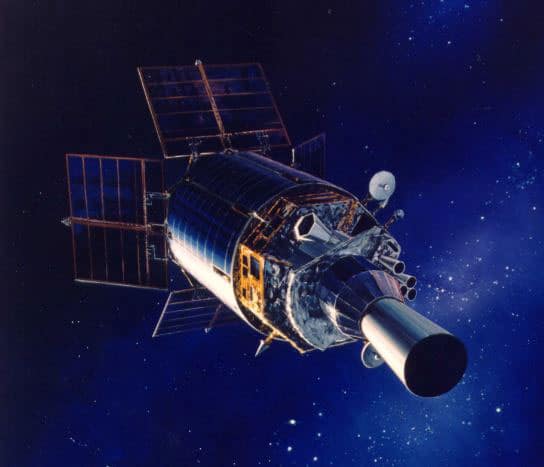The Defense Support Program (DSP) is a satellite constellation in geosynchronous orbit (GEO) that detects rocket launches and nuclear detonations with infrared sensors. DSP satellites are operated by the U.S. Space Force.1
DSP’s first satellite launch took place in 1970. Although the constellation remains operational, its military mission is now primarily satisfied by the Space-Based Infrared System (SBIRS) program.
Specifications
DSP satellites provide the United States with a continuous space-based early warning capability. The satellites include a spinning sensor with short- and mid-wave infrared radars that have a 10-second revisit rate, though they are not dynamically taskable. The first DSP satellite that was launched in 1970 had a design life of a little over a year and weighed 2,000 pounds, had 400 watts of power, and included 2,000 detectors.2
Satellites currently in operation have a design life of five years, weigh approximately 5,250 lb. (2,386 kg), have 1,516 watts of power provided by solar panels, and host 6,000 detectors each. They measure 10 m in height in orbit (8.5 m at launch) and 6.7 m in diameter in orbit (4.2 m at launch). Each unit is estimated to cost around $400 million.3
DSP satellites orbit in a geosynchronous trajectory 22,300 miles (35,970 km) above earth’s surface.4 They have been launched several rocket types, including Titan IIIC, Titan 34D, Titan IV, Titan IVB, Delta IV Heavy, and, on one occasion, a space shuttle.5
Development, Testing, and Fielding

The USAF originally developed DSP satellites in response to the growing threat from Soviet and Chinese nuclear ballistic missiles during the 1960s. Between 1970 to 2007, the USAF launched 23 such satellites into orbit.6 At the end of the Cold War, DSP satellites were retooled for additional tasks. During Operation Desert Storm in the early 1990s, for instance, DSP satellites were used to detect Iraqi Scud missile launches and helped provide early warning to civilians and coalition forces in the region. 7 The system’s infrared sensors have also been used to detect and assess volcanic activity and natural and manmade fires.8
Information provided by the system is gathered and disseminated by the USAF 2d Space Warning Squadron, a unit within the 460th Operation Group located at Buckley AFB, Colorado, which has performed this role since 1992. 9 The U.S. military is working to replace the ageing DSP system with the Space-Based Infrared System (SBIRS), which will feature improved sensors to track smaller-scale or more obscure threats.10
In June 2020, the U.S. Defense Department awarded a $222.5 million life extension contract for DSP. Contracted work will continue up to March 31, 2030.11
Footnotes
- U.S. Air Force Fact Sheet, “Defense Support Program Satellites,” November 23, 2015, https://www.af.mil/About-Us/Fact-Sheets/Display/Article/104611/defense-support-program-satellites/.
- U.S. Air Force Fact Sheet, “Defense Support Program Satellites,” November 23, 2015, http://www.af.mil/AboutUs/FactSheets/Display/tabid/224/Article/104611/defense-support-program-satellites.aspx.
- U.S. Air Force Fact Sheet, “Defense Support Program Satellites,” November 23, 2015, http://www.af.mil/AboutUs/FactSheets/Display/tabid/224/Article/104611/defense-support-program-satellites.aspx.
- National Museum of the U.S. Air Force Fact Sheet, “Northrop Grumman Defense Support Program Satellite,” June 7, 2016, http://www.nationalmuseum.af.mil/Visit/MuseumExhibits/FactSheets/Display/tabid/509/Article/196337/northrop-grumman-defense-support-program-satellite.aspx.
- National Museum of the U.S. Air Force Fact Sheet, “Northrop Grumman Defense Support Program Satellite,” June 7, 2016, http://www.nationalmuseum.af.mil/Visit/MuseumExhibits/FactSheets/Display/tabid/509/Article/196337/northrop-grumman-defense-support-program-satellite.aspx.
- National Museum of the U.S. Air Force Fact Sheet, “Northrop Grumman Defense Support Program Satellite,” June 7, 2016, http://www.nationalmuseum.af.mil/Visit/MuseumExhibits/FactSheets/Display/tabid/509/Article/196337/northrop-grumman-defense-support-program-satellite.aspx.
- U.S. Air Force Fact Sheet, “Defense Support Program Satellites,” November 23, 2015, http://www.af.mil/AboutUs/FactSheets/Display/tabid/224/Article/104611/defense-support-program-satellites.aspx.
- National Museum of the U.S. Air Force Fact Sheet, “Northrop Grumman Defense Support Program Satellite,” June 7, 2016, http://www.nationalmuseum.af.mil/Visit/MuseumExhibits/FactSheets/Display/tabid/509/Article/196337/northrop-grumman-defense-support-program-satellite.aspx.
- U.S. Air Force Fact Sheet, “Defense Support Program Satellites,” November 23, 2015, http://www.af.mil/AboutUs/FactSheets/Display/tabid/224/Article/104611/defense-support-program-satellites.aspx.
- U.S. Air Force Fact Sheet, “Defense Support Program Satellites,” November 23, 2015, http://www.af.mil/AboutUs/FactSheets/Display/tabid/224/Article/104611/defense-support-program-satellites.aspx.
- Matthew Nelson, “Northrop Gets $223M Contract to Sustain Defense Support Program Satellites,” GovConWire, June 29, 2020, https://www.govconwire.com/2020/06/northrop-gets-223m-contract-to-sustain-defense-support-program-satellites/.
